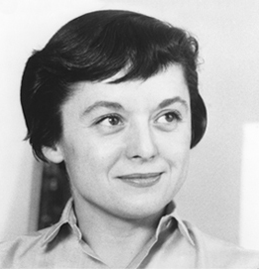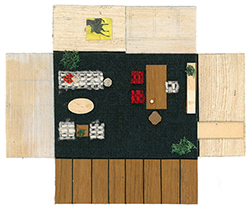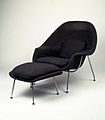Florence Knoll facts for kids
Quick facts for kids
Florence Knoll Bassett
|
|
|---|---|
 |
|
| Born |
Florence Schust
May 24, 1917 Saginaw, Michigan, U.S.
|
| Died | January 25, 2019 (aged 101) Coral Gables, Florida, U.S.
|
| Education |
|
| Occupation | Designer |
| Organization | Knoll, Inc. |
| Known for | Modernizing interior design for offices and workplaces |
| Style | Modernism |
| Spouse(s) |
|
| Awards | National Medal of Arts, 2003 |
Florence Knoll Bassett (born Florence Schust) was a famous American architect, interior designer, and businesswoman. She changed how offices looked and worked. She brought modern design to workplaces. With her husband, Hans Knoll, she built a company called Knoll Associates. It became a top company for furniture and interior design.
Florence helped make interior design a respected profession. She worked hard against old ideas that it was just a hobby for women. She was known for her open office plans. These offices had modern furniture. They were designed smartly for people working there. Her modern style used clean lines and clear shapes. She made them feel friendly with textures, natural forms, and colors.
Contents
Early Life and Learning
Florence Marguerite Schust was born in Saginaw, Michigan, on May 24, 1917. She was called "Shu" by her family and friends. Her father died when she was five. Her mother died when she was twelve. Florence became an orphan at a young age.
A guardian helped Florence go to boarding school. She chose to attend Kingswood School Cranbrook. This school was part of the Cranbrook Educational Community in Michigan. There, she met Rachel de Wolfe Raseman, an art director. They designed a house together. This project made Florence interested in architecture.
The president of Cranbrook Academy of Art, Eliel Saarinen, noticed her talent. Eliel and his wife, Loja Saarinen, treated Florence like family. She spent summers with them in Finland. She became friends with their son, Eero Saarinen. He even taught her about architecture.
Florence studied architecture at Cranbrook Academy of Art. She also studied town planning at Columbia University. She later explored making furniture with Eero Saarinen and Charles Eames. In 1938, she met Alvar Aalto. He told her about the Architectural Association School of Architecture in London. She studied there and liked its focus on studio work. She was inspired by Le Corbusier's International style. She left when World War II began.
In 1940, Florence studied with famous Bauhaus leaders. She worked for Walter Gropius and Marcel Breuer. Even though her studies were interrupted, she wanted to finish her degree. She enrolled at the Illinois Institute of Technology. She studied under Mies van der Rohe. She earned her architecture degree in 1941. Mies van der Rohe greatly influenced her. Her designs became very clear and geometric.
Her Amazing Career
After graduating, Florence moved to New York in 1941. She worked for several architects. She said, "Being a woman, I was given interiors." This meant she mostly designed inside spaces. She started working with Hans Knoll. She designed an office for a client. She also designed showrooms for his furniture company.
In 1943, she joined Hans Knoll's company. She started their interior design service, the Knoll Planning Unit. Florence and Hans Knoll married in 1946. She became a full business partner. The company then became Knoll Associates, Inc.
Knoll Associates: A Design Powerhouse
Florence Knoll helped Hans Knoll turn his small furniture company into a global leader. Florence was the creative design force. Hans was a skilled and charming businessman. They opened a new furniture factory in Pennsylvania. They carefully added dealers for Knoll's furniture.
Knoll Showrooms and stores grew worldwide. By 1960, the company made $15 million a year. The showrooms showed customers how to use their modern furniture. The first showroom opened in New York City in 1948. Others followed in cities like Dallas, Chicago, and Paris. The company also expanded into textiles, creating Knoll Textiles.
Florence believed that architects should also design furniture. She used her international connections. She brought her designer friends and former teachers to Knoll. She convinced famous architects like Eero Saarinen, Marcel Breuer, and Mies van der Rohe to design furniture for Knoll.
For example, Florence asked Saarinen to design a chair. She wanted it to be "like a great big basket of pillows." This led to his famous Womb chair. Knoll also persuaded Mies van der Rohe to give Knoll the rights to his Barcelona Chair. She also worked with artists like Isamu Noguchi and Harry Bertoia. Bertoia created his well-known wire chairs for Knoll. Florence attracted top designers by paying them well. She also made sure they got credit for their designs.
Knoll Planning Unit: Changing Office Design
Florence Knoll created the Knoll Planning Unit in 1943. This was the interior design service of Knoll Associates. She led it until 1965. The unit first designed Knoll Showrooms. They arranged furniture to show how to use the company's designs. These showrooms helped convince clients to use Knoll's modern style.
After World War II, many new office buildings were built. The Knoll Planning Unit was ready for this. They offered new, complete design solutions for offices. This included everything from planning the space to choosing furniture. Florence also improved office design by studying how people worked. She designed functional spaces to meet their needs. She interviewed clients to understand their work.
The Unit designed over 70 office interiors. These included offices for major companies like IBM, GM, and CBS. Their big break came from designing for CBS president, Frank Stanton. He was impressed by the Knoll Showrooms. Stanton told his friends about Knoll's designs. Knoll cleverly promoted their work for CBS in design magazines. The Planning Unit usually had a small team. Even as projects grew, they only had about 20 employees. Florence taught and guided her designers. Many of them later started their own design divisions. People even called the Planning Unit "Shu U" after Florence's nickname.
The "Knoll Look"
Florence Knoll and her Planning Unit changed office design forever. They replaced old styles with the "Knoll Look." This look featured smart space plans, modern furniture, and sleek shapes. It also blended structure, color, and texture. In the 1940s, offices often had heavy, old-fashioned desks. These desks were placed diagonally in corners.
Knoll replaced these with light, modern desks. She also placed them straight. Workspaces became more open. They had sitting areas for casual talks. She redesigned conference tables into a boat shape. This allowed everyone to see each other during discussions. She often used floating staircases and multi-level interiors. This showed her architectural background.
Knoll completely changed how interior spaces were planned. She created a "total design" approach. This meant interior architecture, furniture, lighting, textiles, and art were all connected. The unit created very innovative office designs. This was thanks to Florence's "humanized modernism." She brought color and texture to modern interiors. This made them more comfortable for everyday use. This "softer modernism" was more appealing to people. It was also used by Charles and Ray Eames and Eero Saarinen.
Florence brought architecture, comfort, efficiency, and space planning into her designs. A critic once said she "probably did more than any other single figure to create the modern, sleek, postwar American office."
Selling Modernism
One of Florence's biggest challenges was getting people to accept modern design. Knoll Showrooms were key to showing the public modern design. But Florence was also great at convincing business leaders. She persuaded them to hire Knoll to redesign their offices.
Florence was known for how she presented her designs. She called her presentations "paste-ups." A "paste-up" was a common term for a draft design. Florence was the first to use this method for interior design. Her paste-ups were small plans of the space. They had fabric swatches, wood chips, and finishes attached. These showed the furniture and other details.
Florence used paste-ups to show how the space would feel. The example picture shows how colors and textures were used. This helped show the "humanized modernism" of Knoll's designs. The paste-ups were important for overcoming resistance to change. They gave executives something they could understand. This made them feel comfortable adopting Knoll's new style.
Furniture Design
Florence designed furniture when Knoll's existing collection didn't have what she needed. She called her pieces "meat and potatoes." They were the basic, useful items among the flashier ones. Florence said she was not a furniture designer. Perhaps she wanted her furniture to be seen as part of a whole design. Still, almost half of Knoll's furniture pieces were her designs. These included tables, desks, chairs, sofas, and benches.
She designed furniture to be useful. But also to show what each part of a room was for. Her furniture also connected to the building's architecture. The furniture had sleek shapes and clear lines. This showed her architectural training. Her furniture turned architecture into human-sized objects.
Making Interior Design a Profession
Before Florence Knoll, interior decoration was often a hobby. It was usually done for homes. Offices were not professionally planned or designed. With her Knoll Planning Unit, Florence changed interior design. She made it a professional field.
Florence combined decoration with architecture and industrial design. She applied this to commercial office spaces. This combination is still at the heart of modern interior design. Florence knew she was creating a big change. In 1964, she told The New York Times, "I am not a decorator... the only place I decorate is my own house." She said this to show the difference between a decorator and a designer. Florence was one of the first to make this clear. She was frustrated that "interior decorator" sounded less important. She felt her skills in furniture design and architecture were much more advanced.
Awards and Honors
Florence Knoll received many awards. These include:
- The Museum of Modern Art's Good Design Award (1950, 1953)
- The first award from the American Institute of Decorators (1954)
- The first woman to receive the Gold Medal for Industrial Design from the American Institute of Architects (1961)
- The International Design Award from the American Institute of Interior Designers (1962)
- The Total Design Award from the American Society of Interior Designers (1977)
- The RISD Athena Award for Creativity and Excellence (1983)
In 1985, she joined the Interior Design Hall of Fame. In 2002, President George W. Bush gave her the National Medal of Arts. This is the highest award for artistic excellence in the U.S. She also received honorary degrees from several universities.
Personal Life
Florence married Hans Knoll in 1946. He died in a car crash in 1955. In 1958, she married Harry Hood Bassett. Florence Marguerite Knoll Bassett died on January 25, 2019. She was 101 years old. She passed away in Coral Gables, Florida.
Images for kids
See also
 In Spanish: Florence Knoll para niños
In Spanish: Florence Knoll para niños






